Some posts on this site contain affiliate links. If you book or buy something through these links, I earn a small commission (at no extra cost to you). Take a look at my privacy policy for more information.
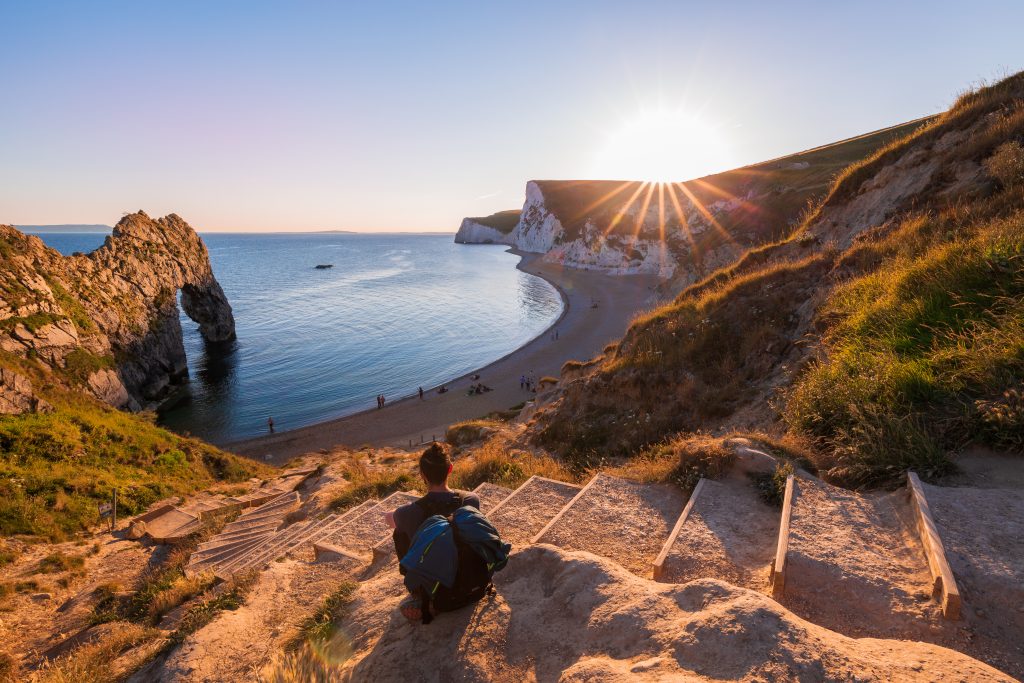
One of the most stunning parts of the UK’s coastline, the Jurassic Coast in Dorset and Devon is justifiably famous.
With 185 million years of history – not to mention some jaw-dropping landscapes and rock formations, caused by aeons of relentless erosion – this UNESCO World Heritage Site is one of the prettiest areas of England. And I promise I’m not just saying that because I’m biased.
This post is a bit of a walk down memory lane for me; these spots were the backdrop to my childhood summers and feature in a lot of my happiest memories! I grew up in Weymouth and spent most of my summers being dragged all along the Dorset coast by my parents.
Those days out in Dorset instilled a lot of random knowledge about geology in my head, but more importantly, a deep-seated love of my home area.
Hopefully, I can share a bit of that love now by encouraging you to visit at least a few of these incredible Jurassic Coast highlights in Dorset…
- Where is the Dorset Jurassic Coast?
- Highlights of the Dorset Jurassic Coast
- 1. Durdle Door
- 2. Lulworth Cove
- 3. Fossil Forest
- 4. Lyme Regis
- 5. West Bay (aka Broadchurch)
- 6. Golden Cap
- 7. Chesil Beach and Fleet Lagoon
- 8. Old Harry Rocks
- 9. Durlston Head
- 10. Kimmeridge Bay
- 11. Dancing Ledge
- 12. Portland Bill
- 13. Winspit
- 14. Charmouth
- 15. Seacombe Cliff
- 16. Undercliff National Reserve
- 17. Gad Cliff and Worbarrow Bay
- 18. Mupe Bay & Mupe Rocks
- 19. Chapman’s Pool
- Map of the Dorset Jurassic Coast Highlights
RELATED POST: The Ultimate Guide to Dorset England
Where is the Dorset Jurassic Coast?
The Jurassic Coast is a UNESCO World Heritage Site stretching 95 miles from Exmouth in East Devon to Studland Bay in Dorset. Most of this stretch of coastline belongs to Dorset, including some of the best-known spots like Durdle Door.
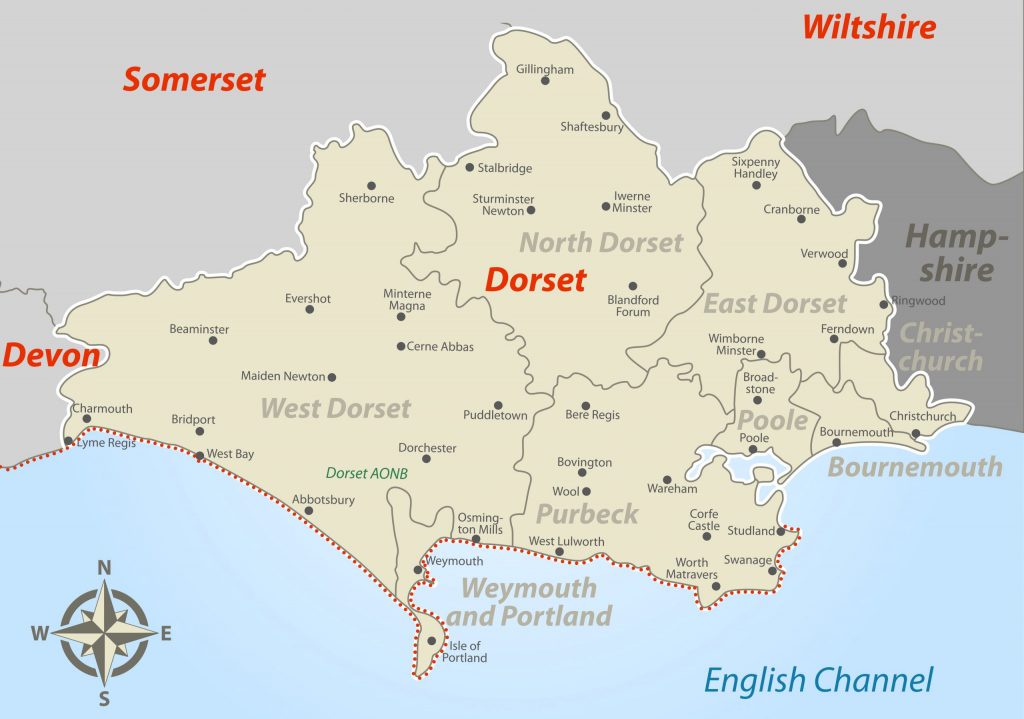
This is a hugely diverse landscape of massive geological importance. Basically, the coastline is made up of rocks spanning some 185 million years of geological history, covering the Triassic, Jurassic and Cretaceous periods.
Most geographic areas only cover one period, so three is a big deal if you’re a geologist. It essentially means the area tells scientists a lot about the environmental changes that have taken place over the ages – literally across hundreds of millions of years.
That’s all interesting enough, but what’s in it for the average tourist who doesn’t have a degree in geology? How about a stunning coastline filled with dramatic rock formations, an abundance of fossils, and lots of lovely beaches tucked into quiet bays and coves? This is a seriously beautiful part of the world, and there are so many incredible places to discover…
Highlights of the Dorset Jurassic Coast
1. Durdle Door
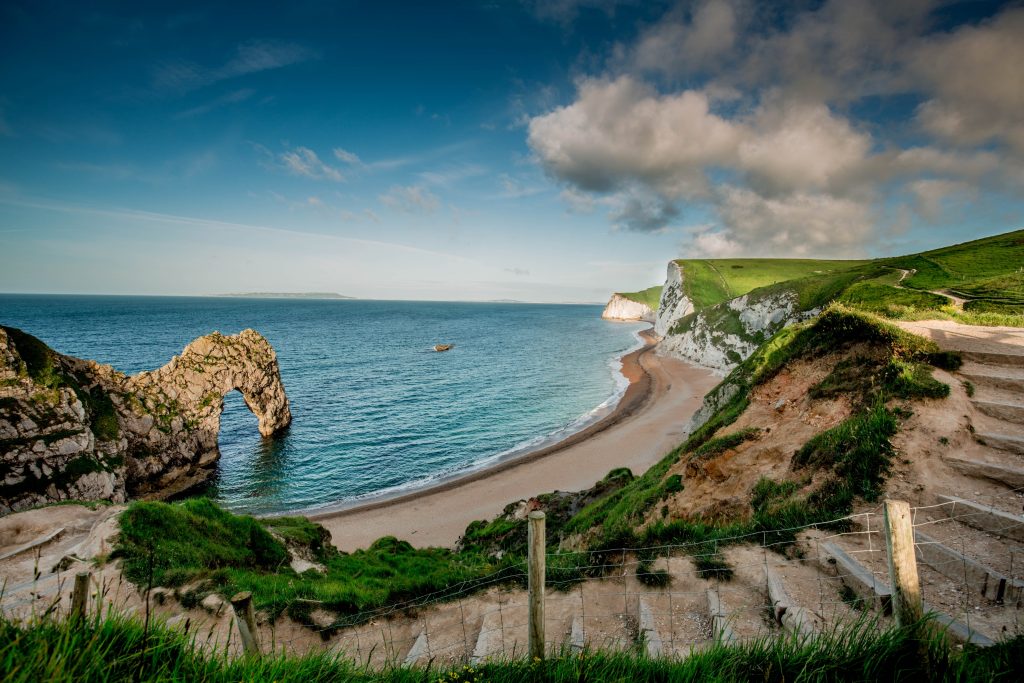
Dorset’s star attraction, and the “poster-child” for the Jurassic Coast, is Durdle Door. The “door” is a natural limestone arch over the sea, caused by millions of years of erosion.
If you want to stay nearby, there’s a caravan site – or a few Dorset glamping spots are nearby for a holiday with a difference.
READ MORE: How to Get to Durdle Door
2. Lulworth Cove

Just next door from Durdle Door is another popular site on the Dorset Jurassic Coast, Lulworth Cove. It’s easy to visit both: you can park in Lulworth and walk over the cliffs to Durdle Door in around an hour. Be warned – it’s a steep climb!
Backed by white chalk cliffs, the bay at Lulworth Cove is almost circular. The area is considered one of the best examples in Europe of the interaction of marine erosion on an alternating sequence of hard and soft rocks. You can see all the different layers in the rocks where they’ve slid up over the ages. Visual proof of the earth’s constant motion!
RELATED POST: 15 of the Best Short Dorset Coast Walks
3. Fossil Forest
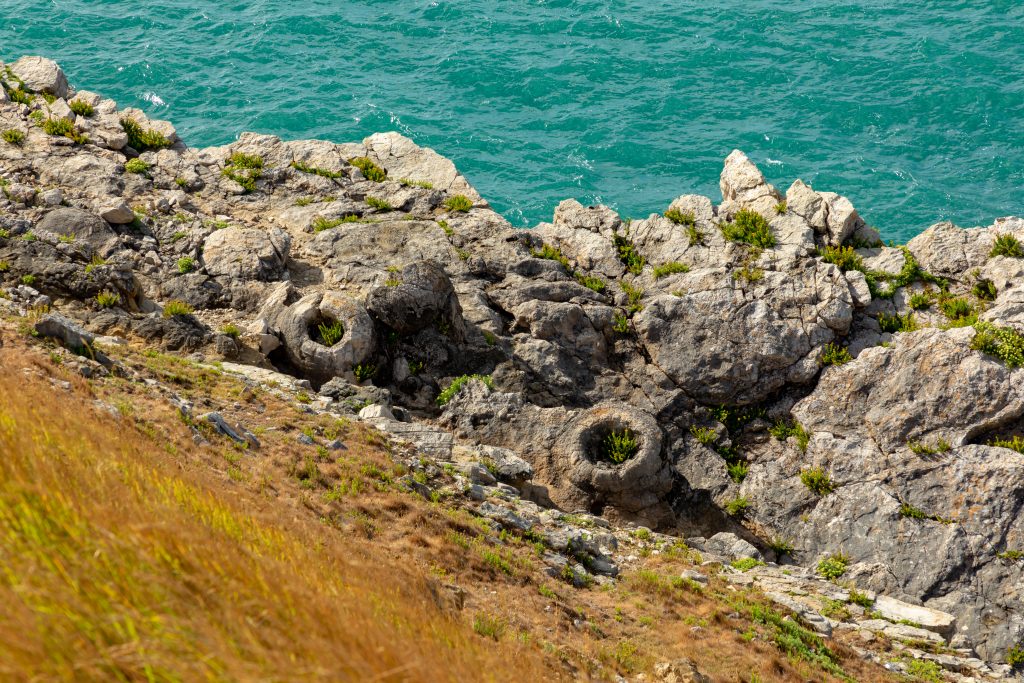
To the east of Lulworth Cove is the Fossil Forest: a cluster of fossilised tree stumps, as well as trunks and roots, all dating from the Jurassic period. It was formed around 150 million years ago, when a temporary drop in sea levels allowed plants and trees to grow in an area that had previously been underwater.
When the climate changed, the water levels rose again and the forest died. But their remains were preserved by layers of calcareous sediment. So at the “forest”, you can walk amongst trees that are older than much of the surrounding rock. It’s pretty cool!
FYI – you can only visit the Fossil Forest when the surrounding army ranges are open. You can check the Range access times here.
4. Lyme Regis

Lyme Regis lies on the Dorset-Devon border, so it’s one of our first coastal landmarks. It’s a pretty seaside town with a small harbour and a lovely beach. But what makes Lyme Regis such an important spot on the Jurassic Coast is the abundance of fossils found in this area, thanks to the local blue lias clay.
The famous Georgian fossil hunter Mary Anning came from Lyme Regis. She discovered the first ichthyosaur skeleton when she was 12 – right here on the beach! There’s a brilliant museum where you can see loads of fossils, and learn more about the history of the area.
WATCH: Attenborough and the Sea Dragon (a BBC Documentary about the Lyme Regis ichthyosaur). And don’t miss my list of the best holiday cottages in Lyme Regis.
READ MORE: Best Fossil Beaches in Dorset
5. West Bay (aka Broadchurch)
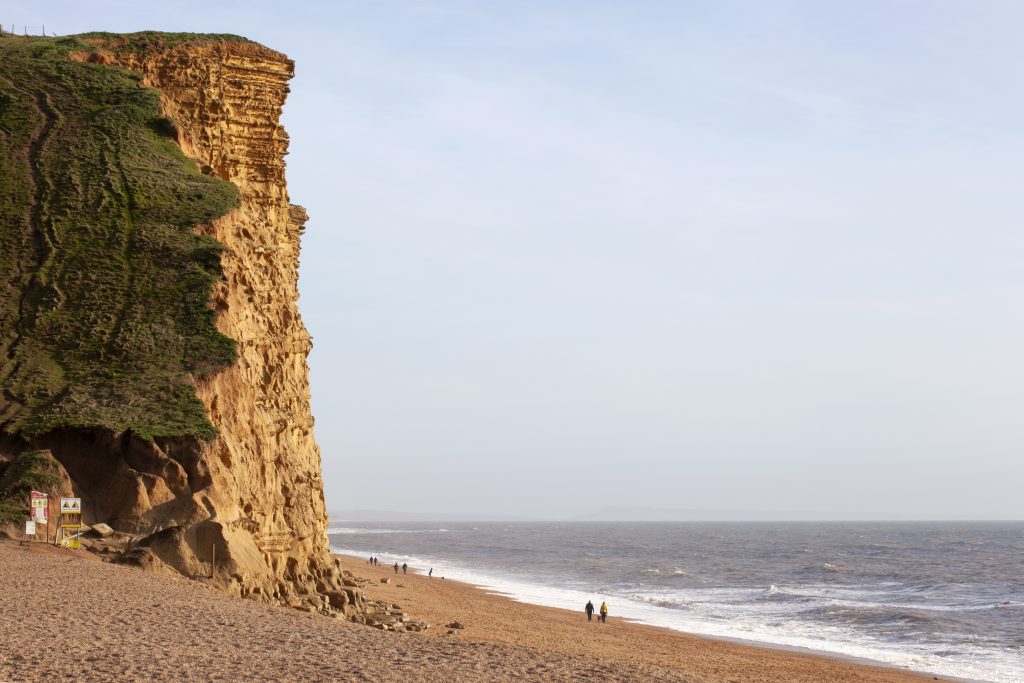
BBC viewers might recognise the towering golden cliffs of West Bay, which starred as the fictional town of Broadchurch in the series of the same name. The crumbling, orangey-coloured cliffs at East Cliff tower above the shingle beach. Their visible layers are significant geographically because they tell the story of falling sea levels from some 175 million years ago.
Insider Tip: East Cliff provides a perfect spot for a cliff walk. Follow the cliff path to neighbouring Burton Bradstock, pop into the Hive Beach Cafe for lunch, and walk back – enjoying the spectacular views of Chesil Beach as you go.
6. Golden Cap
Just west of West Bay is the Golden Cap. This towering, rust-yellow cliff is the highest point on the South Coast of England. At 191 metres (627 ft), it’s a bit of a climb, but the views from the top are well worth it!
7. Chesil Beach and Fleet Lagoon

Starting on the Isle of Portland, Chesil Beach stretches 18 miles along the coast to West Bay. This is a barrier beach, disconnected from the land, so on its way it forms the Fleet Lagoon, a brackish-water lagoon tucked between the beach and the mainland.
Geographically, the feature is pretty important – I can remember spotting it in my high school geography textbooks – but there’s also a lot of exciting local folklore and history in the area, too.
At the Portland end, the pebbles of Chesil Beach are almost fist size, but they get smaller as you move westward. By the time the beach reaches West Bay, the pebbles are tiny. Legend has it that smugglers of old used to land on the beach in the dead of night, and judge where they were by the size of the shingle.
8. Old Harry Rocks
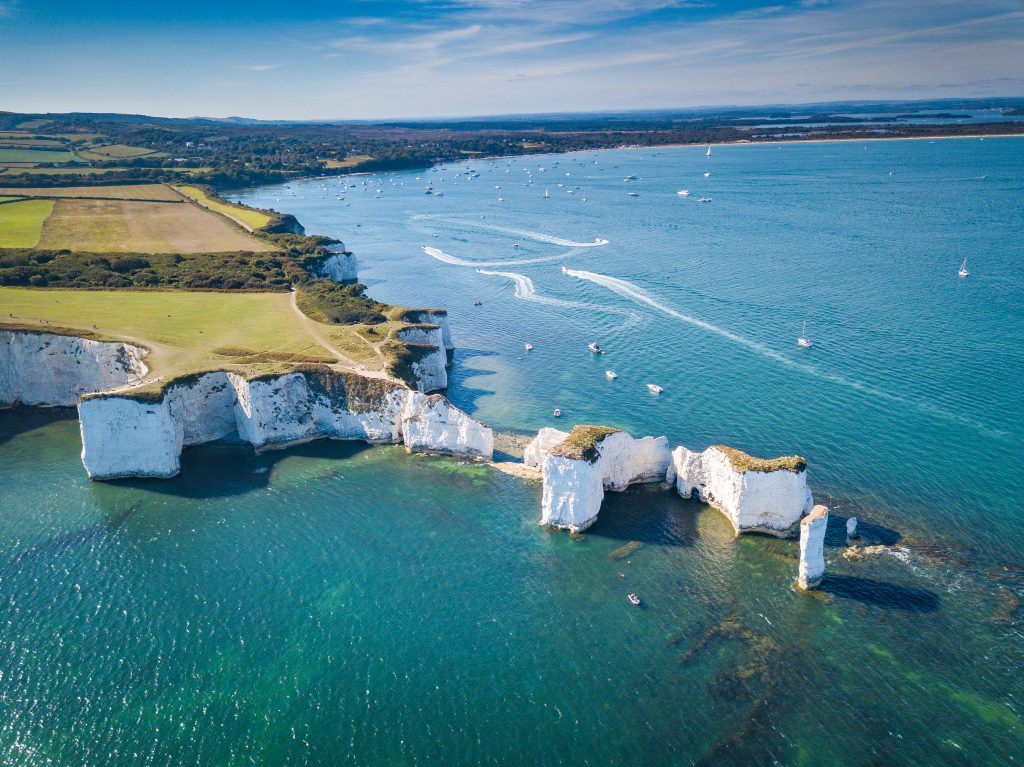
Old Harry Rocks mark the easternmost point of the Dorset Jurassic Coast. These are three chalk rock formations stretching out into the sea from the Isle of Purbeck. Local legend holds that the rocks are named after Harry Payne, a pirate from nearby Poole.
Interestingly, these are part of the same chalk band as The Needles on the Isle of Wight. Once upon a time, it was all connected, but the band eroded over time and now all that remains are a few stacks at either end. On clear days you can glimpse The Needles in the distance.
READ MORE: Try my 4-Mile Circular Old Harry Rocks Walk
9. Durlston Head
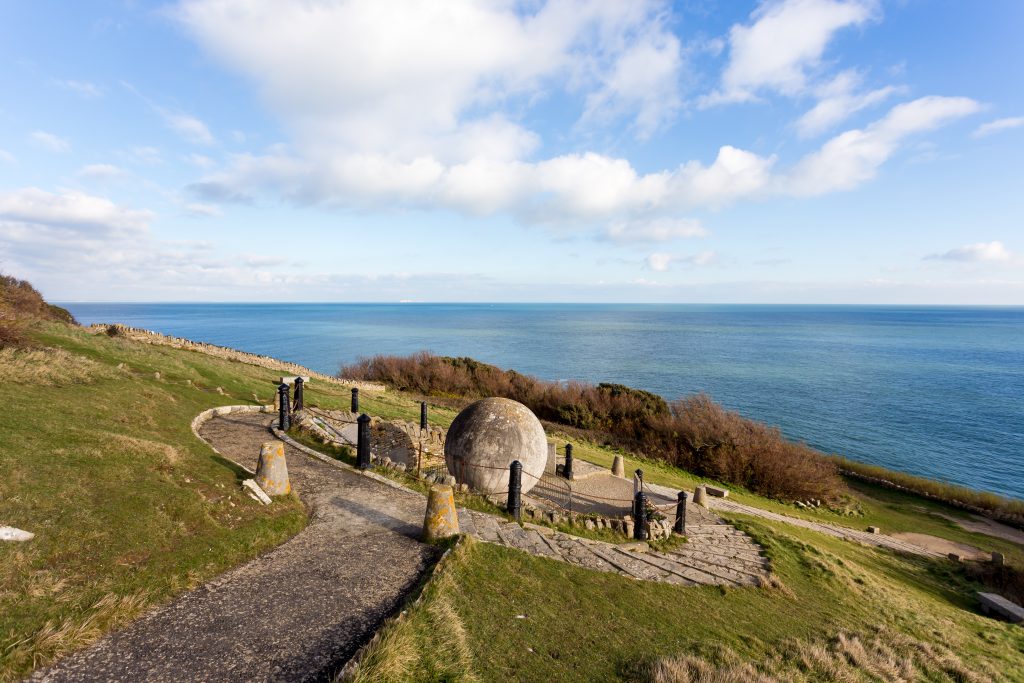
Topped by a castle and a rich nature reserve, Durlston Head is a headland in the southeast corner of the Isle of Purbeck. The dramatic cliffs offer amazing sea views, but the area is better known for its wildlife. The 320-acre country park is home to hundreds of species of wildflowers, as well as butterflies, birds, and invertebrates.
10. Kimmeridge Bay
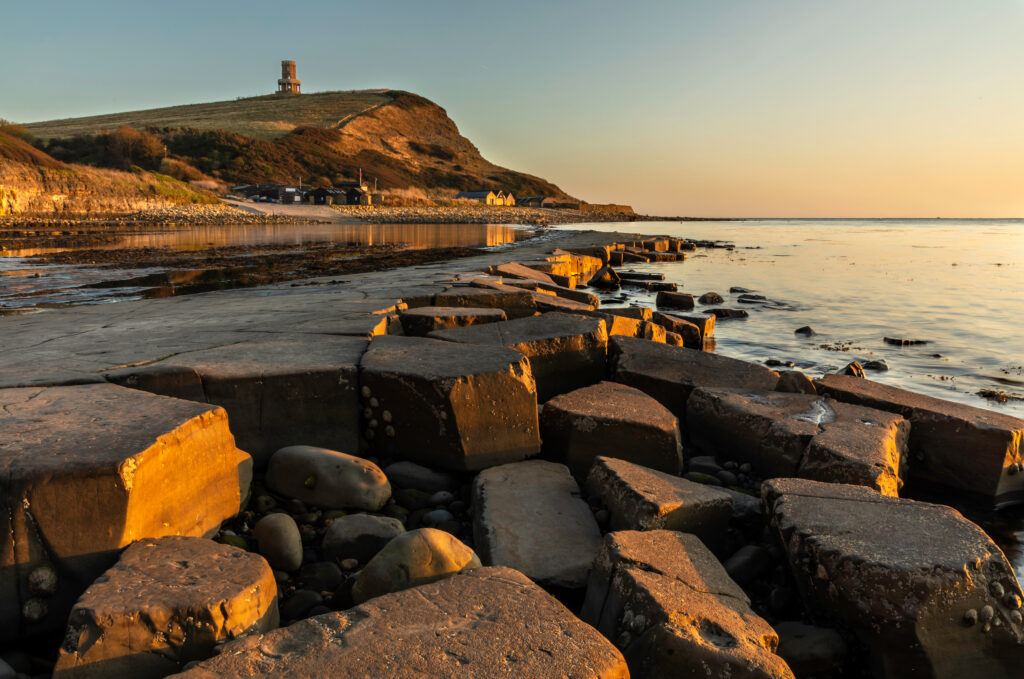
Another spot well-known for wildlife is Kimmeridge Bay. This sweeping bay lies within a marine Special Area of Conservation. Not only is this one of the safest and best locations for snorkelling, but it’s also the best place for rock pooling in Dorset. The rocky layers of the beach from dozens of pools and puddles, so you can easily get an up-close glimpse of the underwater world.
11. Dancing Ledge
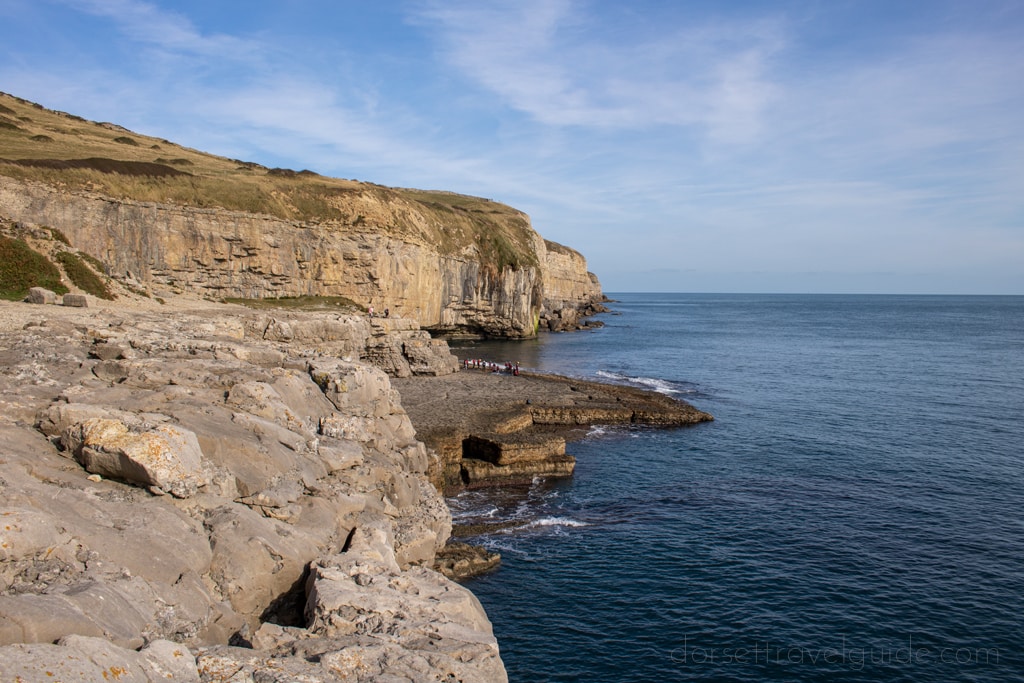
Dancing Ledge is a flat rock ledge that lies at the base of a small cliff near Langton Matravers. It’s named, apparently, because the bobbing waves at certain tides make the ledge look like it’s dancing. It’s also pretty tricky to reach as you have to scramble a bit to get there!
A manmade swimming pool was blasted into the rock here in the late 19th century. It was made for pupils of local prep schools.
Although most of the nearby schools have now closed, the swimming pool remains a popular feature of Dancing Ledge. Every high tide, the pool’s water is refreshed, and on summer days it slowly warms in the sunshine at low tide.
READ MORE: 5.5 Mile Circular Dancing Ledge Walk or try my 3.4 Mile Scratch Arse Ware and Dancing Ledge Walk
12. Portland Bill
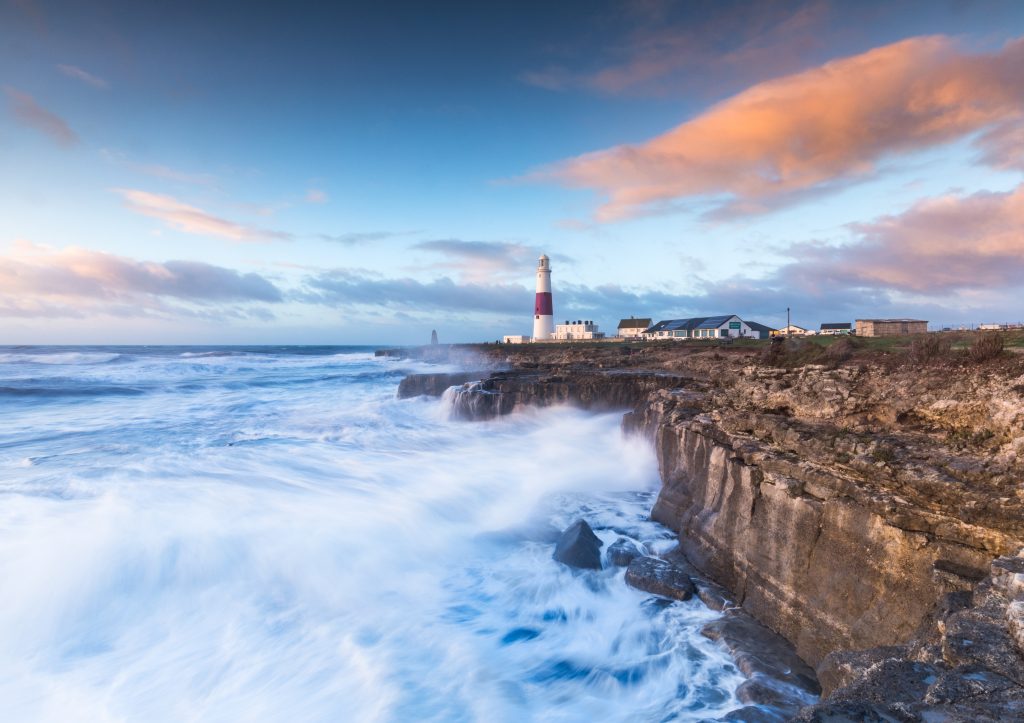
Joined to the mainland by the shingle arc of Chesil Beach, the Isle of Portland stretches out into the English Channel. Its southern tip, Portland Bill, features a dangerous and dramatic coastline.
Even if you’ve never heard of Portland, chances are you’ve seen its stone. Portland Limestone was used to build St Paul’s Cathedral in London, as well as countless other important buildings.
At Portland Bill, the artificial stack Pulpit Rock stands as a testament to the quarry that once worked there. There are several others on the island, some still working. One, Tout Quarry, has now been made into a lovely sculpture park and nature reserve.
RELATED: Portland Bill Short Circular Walk
13. Winspit
Speaking of quarries, over in Worth Matravers lies Winspit. This is a disused quarry just along the coast from Dancing Ledge. Although many of the caverns are closed for safety reasons, you can still enter some of them. It’s quite a bizarre feeling to wander into the caves with the whole weight of the cliffs above you!
14. Charmouth
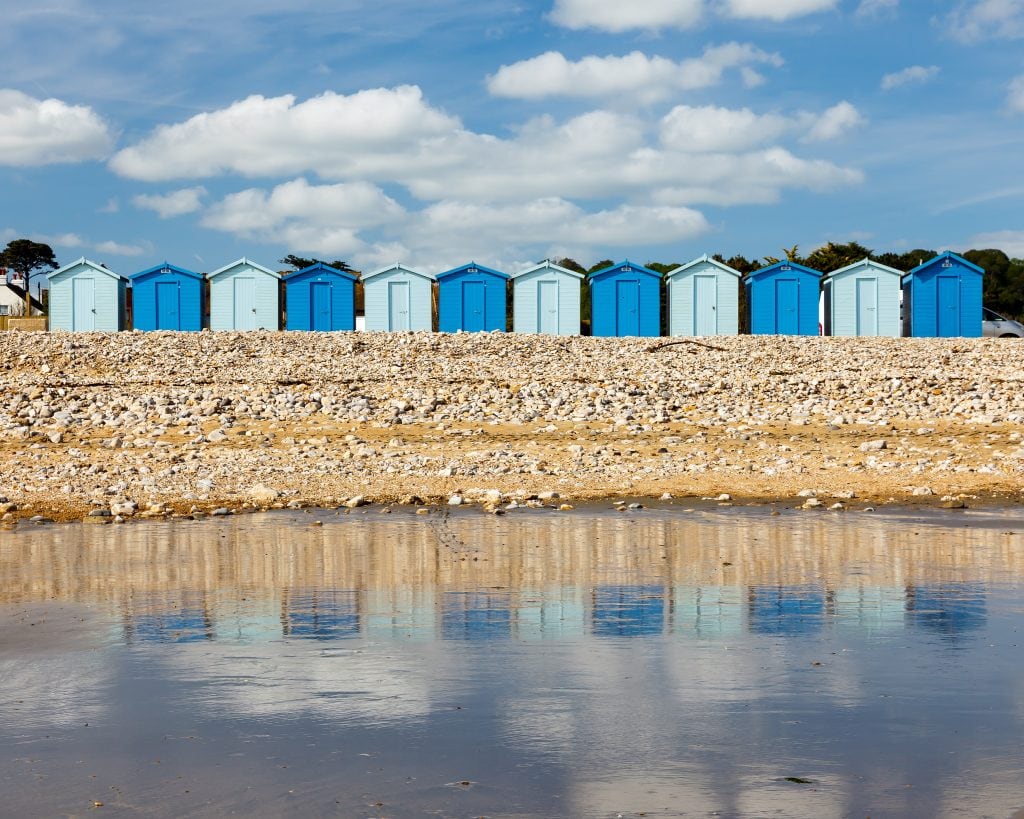
A quaint little seaside village, Charmouth makes for a charming day out. (Excuse the terrible pun!). Think thatched-roofed cottages and pastel blue beach huts on the shingle beach.
But, like nearby Lyme Regis, Charmouth is another hotspot for fossil hunting. Last time I visited I found a small ammonite! The Charmouth Heritage Coast Centre has loads more history and info. They also offer guided fossil hunting walks along the beach.
READ MORE: My Lyme Regis to Charmouth Walk is perfect for fossil hunting!
15. Seacombe Cliff
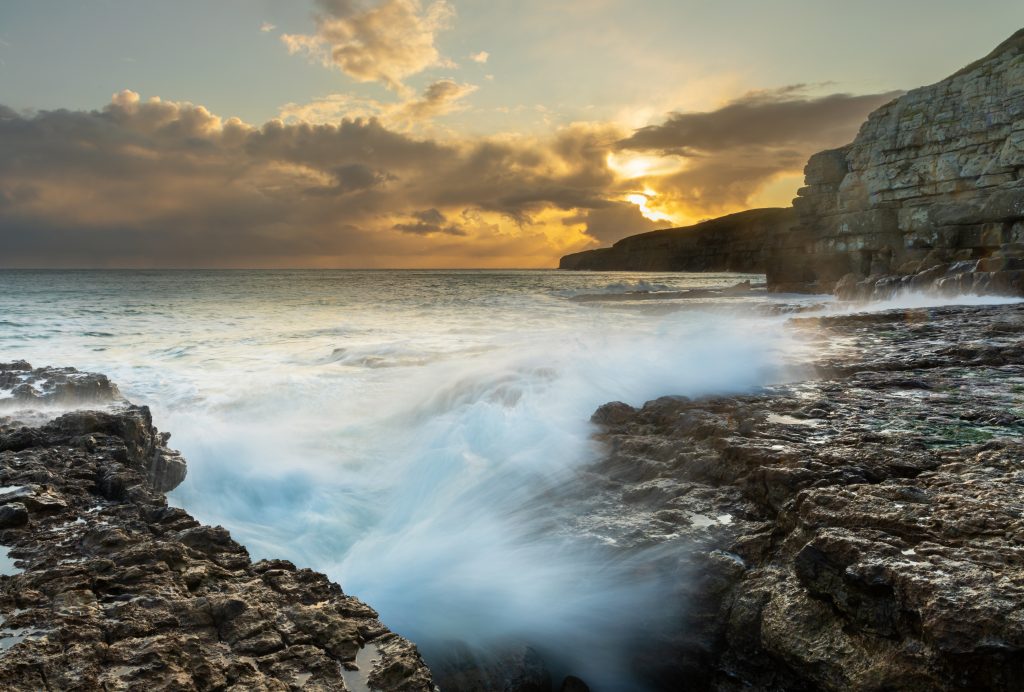
Seacombe is another disused stone quarry. It lies between Dancing Ledge and Winspit, and the wild beauty of the area is ideal for walking.
At Seacombe, the quarries left behind a low-level platform from which they used to lower rocks to the waiting barges in the sea. Today, that platform has become a popular swimming spot. If you can brave the chilly waters of the English Channel, that is!
16. Undercliff National Reserve
Starting at Seaton in Devon, a challenging section of the South West Coast Path crosses the border and leads all the way to Lyme Regis. On the way, it passes through one of the highlights of the Jurassic Coast, the Axmouth to Lyme Regis Undercliffs National Nature Reserve.
The reserve is one of the largest active coastal landslide systems in Western Europe, so you need to be careful walking here. Pay attention to signs and check for weather warnings before starting out.
17. Gad Cliff and Worbarrow Bay
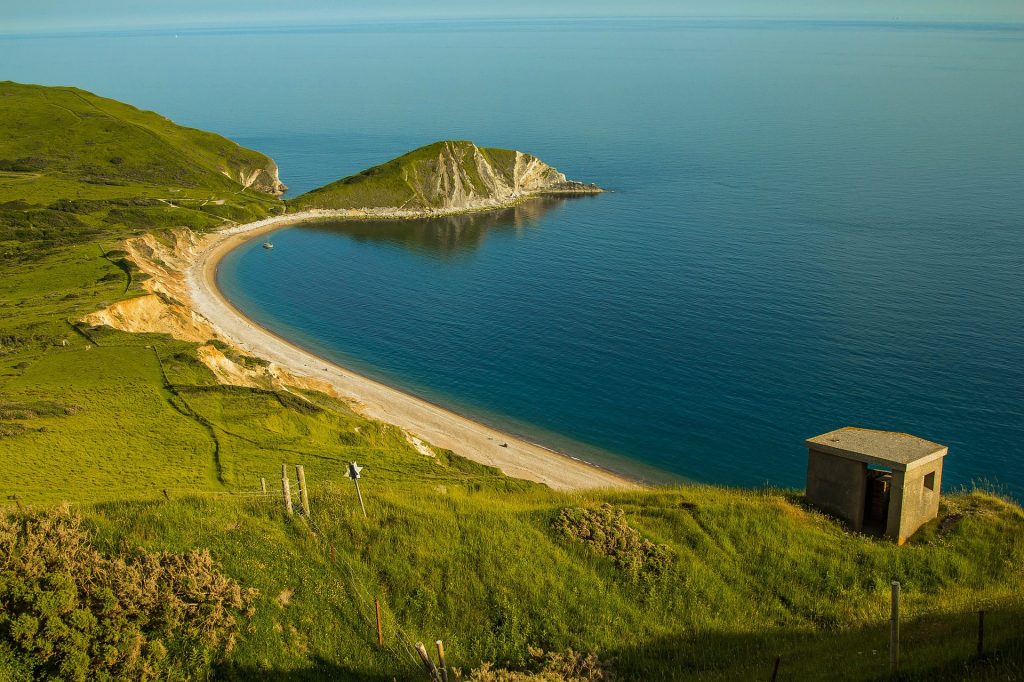
Worbarrow Bay is a wide, sweeping bay on the Isle of Purbeck. At its eastern end, the slumping figure of Gad Cliff juts into the sea. It’s a short, but steep, climb to the top, and the resulting views along the coastline are well worth it. It’s also is one of the quieter beaches in the area, perfect if you’re looking for a bit of seclusion!
The nearest parking is a mile away, at the village of Tyneham, which is also worth exploring. This small village was abandoned during WWII as the army needed the area for practice. Their ranges are still found all over the area. Today, several of the buildings have been lovingly restored in order to show what rural life was like in the 1940s.
18. Mupe Bay & Mupe Rocks

Just around the corner from the more famous Lulworth Cove, Mupe Bay is something of a hidden gem. At one end of the bay, a string of tooth-like pointed rocks juts up from the sea. Low tide also uncovers Mupe Ledge, a flat expanse of rock that is often covered with rockpools.
19. Chapman’s Pool
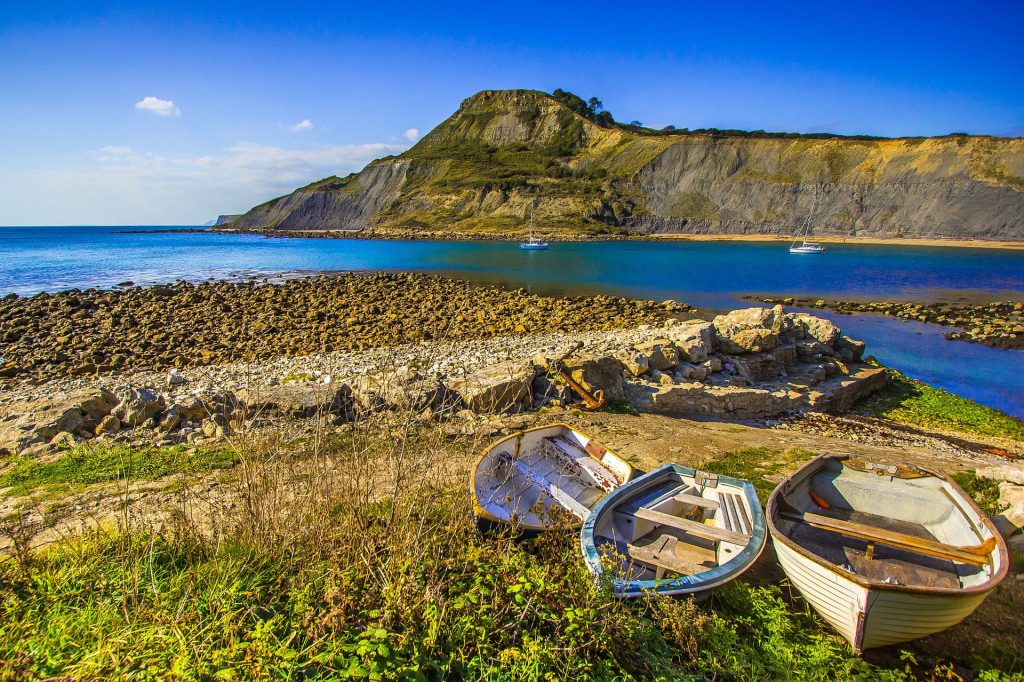
Last, but no means least, we have Chapman’s Pool. This small cove near Worth Matravers is another highlight of the Purbeck section of the Jurassic Coast. It’s backed by high cliffs, which provide shelter to the cove, but also make it a bit of a challenge to reach. Around the area are limestone cliffs and dramatic caves.
Like other local limestone areas, the rocks around the cove are full of fossils. The beach itself is wonderfully wild, broken by a small stream which plunges through a ravine in the cliffs to reach the sea.
READ MORE: Chapman’s Pool Walk from Kingston
Map of the Dorset Jurassic Coast Highlights
Are there any other Dorset Jurassic Coast highlights that I’ve missed? Scroll down and leave a comment!


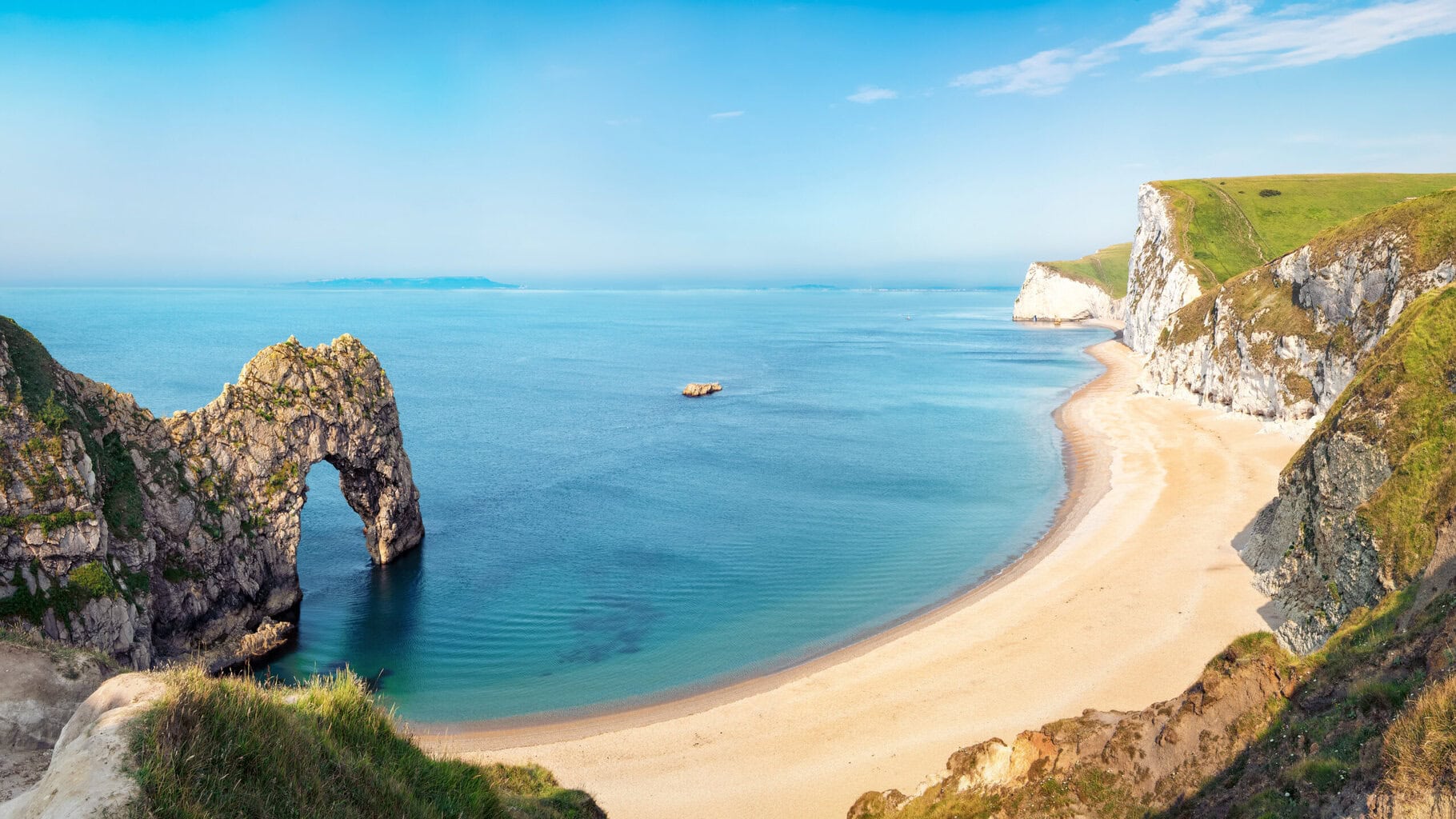
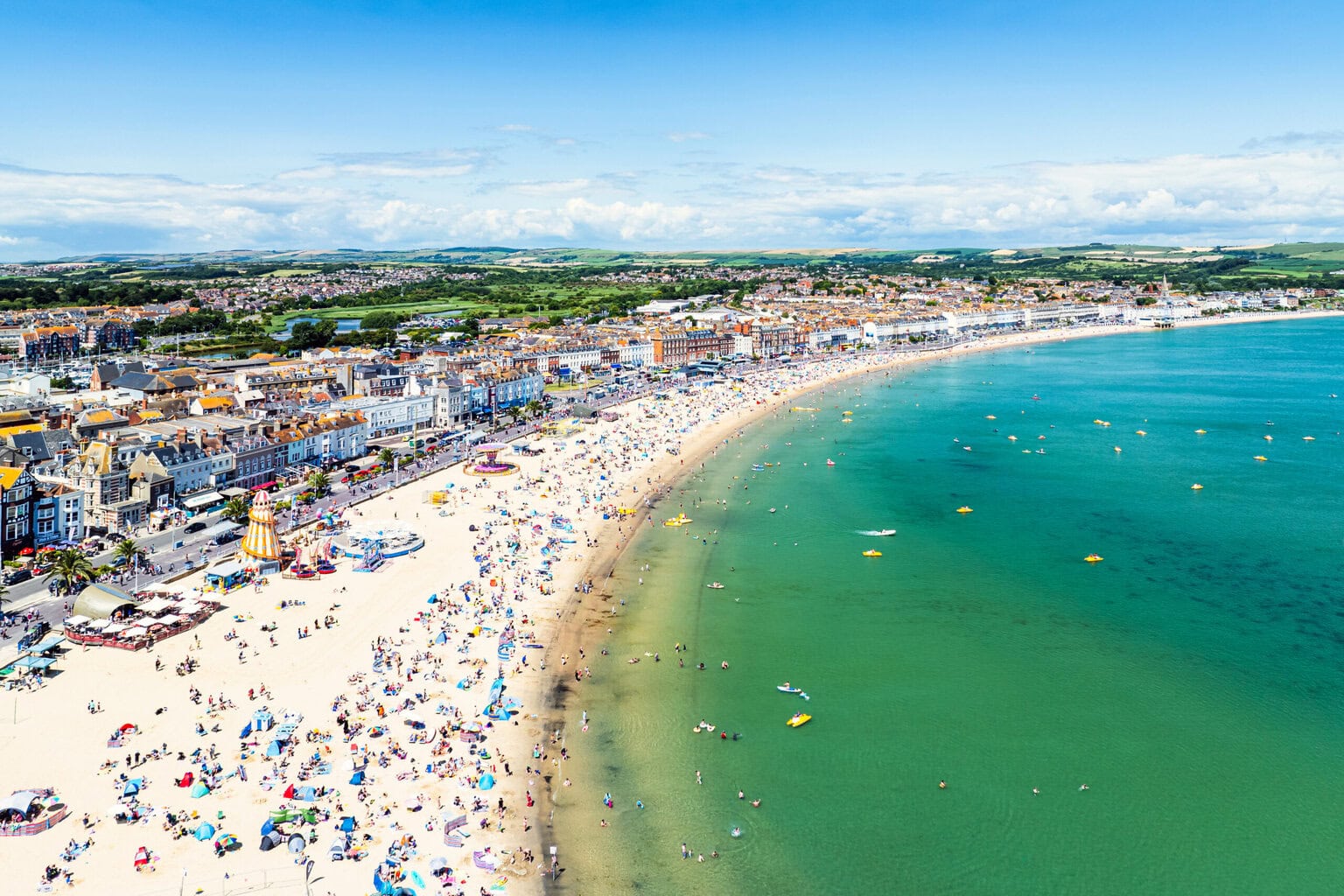
Well presented and full of information . Also this is a good place for family outing.
Thanks so much Patrick!
We are planning to go to the Jurassic Coast on Easter as my daughter is obsessed with fossils at the moment. I found this article the best among all the ones that are shown when you start the search online. Hopefully, we can make it this year. Now looking for places to stay there.
Thanks so much for commenting Patricia, this is lovely 🙂 If your daughter is into fossils I highly recommend Lyme Regis and Charmouth. I’ve never walked on that beach without seeing a fossil or two! And there’s the Ammonite Pavement there at low tide which has thousands embedded in it. Plus the museum there is excellent. Hope you have a brilliant trip!
Thanks for the tips!
We will be on a cruise to the British Isles, and have found our day in Dublin has been cancelled. Instead, we will be visiting Portland, and this area. Can you recommend the best way for us to see this area as a port stop on a cruise? Thank you very much!
Hi Connie! Sorry to hear your Dublin day got cancelled, I hope you’ll enjoy Portland and Weymouth just as much. I have an article I wrote for my other website about how to see Weymouth in one day if you’re visiting on a cruise, you might find this helpful: https://www.emilyluxton.co.uk/uk/top-weymouth-attractions/
Do you have any ideas in mind for what you’d like to do? You could arrange for a taxi from the harbour on Portland to explore the island, or head into Weymouth.
Hi
We are from Australia and wanted on our next trip to visit some of the Jurassic coast ( & inland ) then go up along the Welsh boarders . We are coffee shop people and due to our luck of living in a great land of natural beauty, we don’t want to spend all our time on walks or exploring beaches but want to see the main sights of what looks like a magnificent area.
we would appreciate any feed back ( aged in 50’s/ 30’s, able to walk etc )
cheers Gillian jewellgill@hotmail.com
Hi Gillian! Thanks for commenting. If you want to see the main sights without spending much time walking you’re in luck, as you can drive to a lot of good viewpoints on the Jurassic Coast. I’d say the “main” sight would be: Durdle Door (you can park at the car park and view it from above, or walk down to the beach if you like), Lulworth Cove, Old Harry Rocks, West Bay, Weymouth Harbour, and maybe Lyme Regis for fossil hunting. You could in fact visit all of them on one day as a road trip if you wanted, although it would be a bit rushed. Inland there’s also Corfe Castle, which I’d say is a must, and maybe Blue Pool, Dorchester is a nice historic town, and there are lots of pretty villages like Shatesbury. Hope that helps!
I was solving the last remaining clue in a quiz based on Dorset. However, try as I may, I cannot find any mention anywhere of the Geo Needle in Dorset, except the one at Exmouth. The quiz setters were from Dorset too which was a bit confusing. Otherwise, your post is really helpful. I’m glad I found you.
Hi Penny. I don’t believe that there is a Geoneedle in Dorset – the only one I know of is at Orcombe Point, which is in Exmouth, Devon and marks the start of the Jurassic Coast. Perhaps the quiz setters got confused?